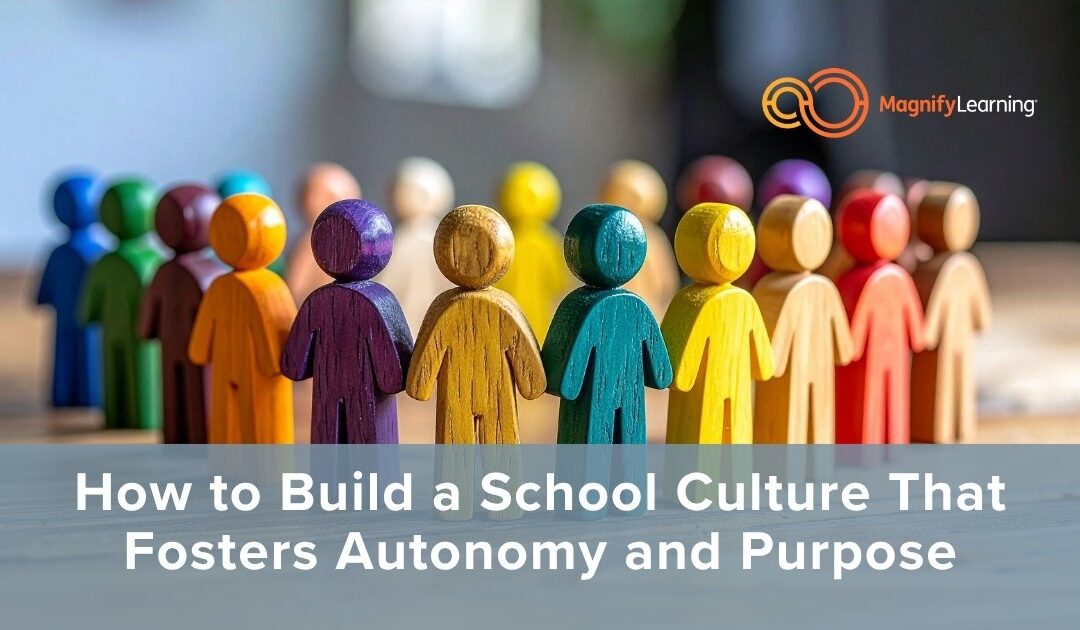What Montessori principles, Project Based Learning, and strong leadership can teach us about real change.
By Ryan Steuer | CEO, Magnify Learning
Leading Beyond Compliance
As a K–12 administrator committed to meaningful Project Based Learning (PBL), you’re not just managing operations—you’re shaping a learning ecosystem. But let’s be honest: change is tough. Especially when you’re trying to move from a traditional, compliance-based model to one that fosters autonomy, critical thinking, and real-world readiness.
This post offers a fresh lens through which to lead that shift. We’ll explore:
- The power of learner autonomy—and how school culture impacts it.
- Why your professional development should look more like a leadership lab than a lecture hall.
- The untapped potential in designing environments (not just lesson plans) that nurture independent thinking.
You’ll walk away with inspiration and action steps to guide your school toward a culture that doesn’t just allow autonomy—it celebrates it. 🎉
1. Learner Autonomy Is Built in Culture, Not Compliance
If your goal is to develop learners who can think independently, solve complex problems, and contribute meaningfully to the world around them, then autonomy isn’t a luxury—it’s the mission. But autonomy doesn’t start in a textbook or a test—it starts with culture.
As Marsha Enright, founder of Reliance College and a lifelong Montessori advocate, explains:
“One of the things that happens with children in Montessori schools is they love the work… it’s given to them in exact amounts that are challenging but not overwhelming.”
Enright’s experience brings to light a critical leadership insight: autonomy thrives in well-designed, intentional environments. It’s not about letting go of structure—it’s about designing the right kind of structure.
So ask yourself:
- Are your learners given meaningful choices about their learning?
- Do your learning environments (physical and social) encourage risk-taking and exploration?
- Are your teachers empowered to adapt, iterate, and co-lead learning with students?
In schools built on compliance, learners do what’s required. In cultures built on autonomy, learners do what matters. 💡
2. Professional Development Must Be Modeled After PBL Principles
Let’s face it: most PD still resembles the very thing we’re trying to transform—lecture-heavy, passive, and detached from real application. If we want educators to lead PBL effectively, we need to offer PD that mirrors PBL itself: collaborative, inquiry-driven, and focused on meaningful problems.
During her interview, Enright shared how she designed a summer program for young adults modeled after Montessori principles. The impact?
“The students at the end of a week would tell me their life had been transformed… They could judge anything for themselves.”
That’s the kind of transformation educators need, too. Not because someone lectured them into understanding—but because they experienced the learning process firsthand. Imagine a leadership training where administrators work through designing an actual learner-centered school initiative, receive peer feedback, and reflect on their leadership style—not just memorize a list of “best practices.”
Want sustainable change? Make professional development a lived experience, not a passive checklist.
✅ Try This: Instead of PD sessions about PBL, run them as PBL. Let your staff identify problems, explore research, pitch solutions, and reflect on what worked.
⭐️Hint: This is exactly the process Magnify Learning’s in-person workshops go through because it’s the way people learn best – engaged and empowered.
3. Design Environments That Teach What Content Can’t
Traditional education often focuses on delivering content. But as Enright notes, the real game-changer is the environment—the space and culture in which learning takes place.
“We consider every aspect of the environment—social, emotional, physical—and how do you maximize that?”
This insight is echoed across leading PBL environments: learning happens best when students feel seen, safe, and inspired. That doesn’t happen by accident. It’s designed.
As an administrator, your job isn’t just about what’s on the walls or in the curriculum—it’s about designing systems that signal: “We trust you to lead your learning.”
This includes:
- Flexible schedules that allow deeper learning and revision.
- Shared norms that support respectful dialogue and collaboration.
- Authentic audiences and community partnerships that make learning purposeful.
Want more critical thinking? Design for dialogue. Want more ownership? Build routines that center learner voice.
🚀 Administrator Challenge: Audit one aspect of your school environment (a hallway, a classroom routine, or even your staff meetings). Ask: Does this reinforce autonomy and purpose?
The Future of School Leadership Is Human-Centered
The shift toward autonomy, purpose, and project-based structures isn’t easy—but it’s necessary. And it starts with you.
As Enright reminds us, “You can’t depend that you’re going to continue in whatever work you’ve started in. Everything changes.”
If we want learners who are adaptable, self-directed, and empathetic—we must lead in a way that models those very qualities.
So here’s your next step:
Pick one small design shift—in your PD, your daily schedule, your leadership approach—and align it more deeply with the principles of autonomy and authenticity.
And remember:
You’re not just leading a school. You’re crafting a culture.
One that empowers learners—and educators—to be the very best versions of themselves. 💪✨
💬 Reflection Prompt:
What’s one change you can make this month to foster more autonomy in your school environment?
Let’s reimagine education—together.
Click here for more information on Magnify Learning’s Workshop options.
To watch a webinar customized to your context, visit us at pblwebinar.com
If you have PBL heroes in your district, have them apply to be a part of our nationwide network tackling current issues in education innovation by going to pblnetworks.com

